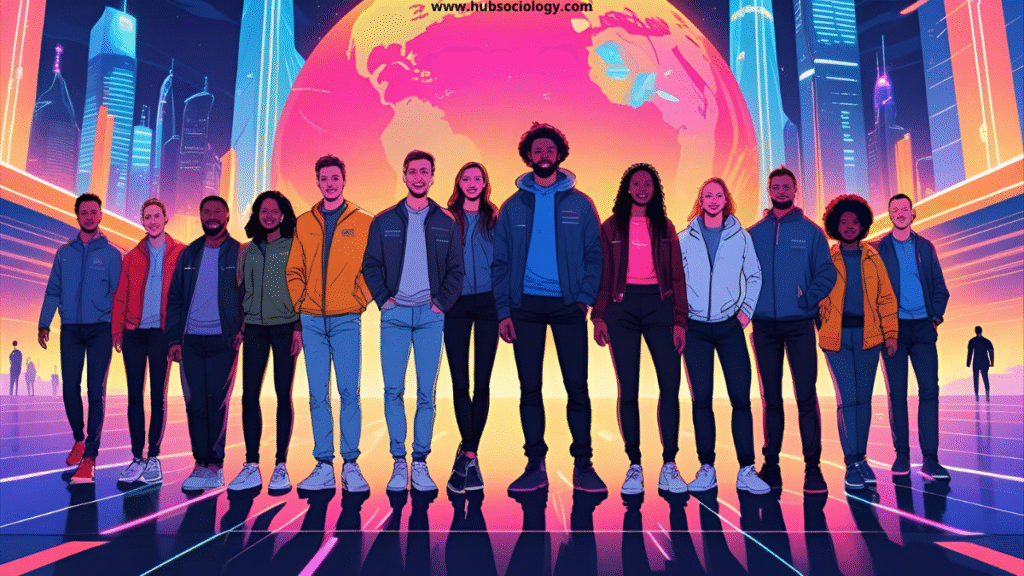Introduction on Social Inequality in the Age of Billionaires
The twenty-first century is often celebrated as the age of unprecedented wealth, innovation, and globalization. Yet beneath the glossy surface of technological revolutions, luxury lifestyles, and the glamour of billionaires lies a stark and disturbing reality: deepening social inequality. In an era where the world’s wealthiest individuals can launch private space missions while millions struggle to access basic healthcare and education, the contrast between the rich and the poor has reached historic proportions. This age of billionaires marks a defining moment in human society—one that demands sociological scrutiny to understand the structures, ideologies, and systems that enable such inequality to persist and grow.
From Karl Marx’s critique of capitalism to Pierre Bourdieu’s theory of capital and inequality, sociologists have long examined how wealth, power, and privilege shape human societies. In today’s globalized economy, where wealth concentration is accelerating faster than ever, sociological perspectives provide a crucial lens for analyzing how the age of billionaires reshapes class structures, labor relations, and even social consciousness.

Table of Contents on Social Inequality in the Age of Billionaires
Historical Context: From Industrial Capitalism to Tech Billionaires
The roots of modern inequality trace back to the Industrial Revolution, which transformed economies through mechanization and created vast fortunes for industrialists like Carnegie, Rockefeller, and Ford. This era introduced a new class of capital owners who dominated production and labor markets, widening the gap between employers and workers. However, the 21st century has witnessed a new phase of capitalism—digital capitalism—where technological innovation, data ownership, and financial speculation have created unprecedented concentrations of wealth.
Billionaires such as Elon Musk, Jeff Bezos, Mark Zuckerberg, and Bernard Arnault represent a new elite: global, corporate, and technologically empowered. Their companies—Tesla, Amazon, Meta, and LVMH—operate beyond national boundaries, wielding influence over global markets, governments, and even culture. The rise of these billionaires signifies not only economic transformation but also a sociological shift toward hyper-capitalism, where the logic of profit and accumulation extends into every sphere of life—from social media to health, from education to environment.
The Sociological Dimensions of Social Inequality in the Age of Billionaires
1. Marxian Perspective: Class Struggle and Capital Accumulation
Karl Marx’s analysis of class conflict remains profoundly relevant in understanding social inequality in the age of billionaires. According to Marx, society is divided between those who own the means of production (the bourgeoisie) and those who sell their labor power (the proletariat). In the contemporary era, billionaires represent the global bourgeoisie—those who control vast networks of capital, production, and information.
Companies like Amazon and Tesla epitomize Marx’s concept of surplus value extraction, where profit arises from the unpaid labor of workers. While Jeff Bezos’s fortune grows into hundreds of billions, Amazon workers often face precarious working conditions, minimal benefits, and strict surveillance. Marx would interpret this disparity as a manifestation of alienation and exploitation, where labor becomes commodified, and workers are distanced from the products of their labor.

The billionaire age thus revives Marx’s warning: capitalism, left unchecked, concentrates wealth and power into fewer hands, creating a social structure ripe for inequality and conflict.
2. Weberian Perspective: Power, Status, and Bureaucracy
Max Weber expanded the concept of inequality beyond economic class to include status and power. In the age of billionaires, these dimensions are deeply intertwined. Wealth not only grants access to material luxury but also to social prestige, political influence, and symbolic power.
Weber’s concept of “life chances” explains how access to resources—economic, cultural, and social—determines individuals’ opportunities and life outcomes. Billionaires possess an almost limitless range of life chances: elite education, political networks, healthcare, and global mobility. Conversely, marginalized groups face barriers in every domain, reinforcing cycles of poverty and exclusion.
Furthermore, Weber’s notion of bureaucratization sheds light on how corporate structures perpetuate inequality. Multinational corporations operate through complex bureaucratic systems that prioritize efficiency and profit over human welfare. Employees become functionaries within these hierarchies, often stripped of autonomy—a phenomenon Weber termed the “iron cage” of modern capitalism.
3. Bourdieu’s Theory of Capital and Symbolic Power
Pierre Bourdieu’s framework of economic, social, cultural, and symbolic capital offers valuable insights into the reproduction of inequality. In the billionaire era, these forms of capital accumulate synergistically. Economic capital (wealth) enhances social capital (networks), which fosters cultural capital (education, taste, prestige), eventually translating into symbolic capital—legitimized power and recognition.
For example, billionaires engage in philanthrocapitalism—the strategic use of charity and donations to influence public policy and social discourse. Figures like Bill Gates or Elon Musk are often celebrated as visionaries or saviors, masking the structural inequalities their business empires perpetuate. Bourdieu would argue that such symbolic power legitimizes inequality, transforming economic dominance into moral and cultural superiority.
Globalization and the New Social Inequality in the Age of Billionaires
Globalization, while celebrated for connecting the world, has also magnified social inequality. The global elite benefits disproportionately from open markets, financial liberalization, and technological advancement, while the global working class faces job insecurity, wage stagnation, and exploitation.
According to sociologist Saskia Sassen, globalization has produced “global cities” like New York, London, and Singapore, which concentrate wealth, capital, and decision-making power. Yet within these cities, extreme poverty coexists with extreme affluence. Luxury penthouses and sprawling slums symbolize the spatial segregation of wealth—a physical manifestation of social inequality.

Moreover, multinational corporations often shift production to countries with cheap labor, exploiting global inequalities in wages and labor rights. This has led to what sociologist Ulrich Beck calls the “risk society”, where the costs of globalization—environmental degradation, job insecurity, and social displacement—are borne by the lower classes.
Digital Capitalism and the Tech Oligarchy
The digital revolution has created not only new industries but also new forms of inequality. Data is now one of the world’s most valuable resources, controlled by a handful of tech giants. These corporations monopolize information flows, manipulate consumer behavior, and amass wealth through algorithms and surveillance capitalism—a concept popularized by Shoshana Zuboff.
In this tech oligarchy, billionaires control platforms that shape public opinion, elections, and even mental health. Social media billionaires like Mark Zuckerberg or Elon Musk wield power far beyond economic domains—they influence democracy, culture, and communication itself. This new form of domination blurs the line between private wealth and public governance, reinforcing what sociologists term “structural inequality.”
Inequality and Democracy
One of the gravest sociological implications of billionaire dominance is its impact on democracy. The concentration of wealth leads to a concentration of power—what C. Wright Mills famously called the “power elite.” This elite, composed of corporate, political, and military leaders, makes decisions that shape society while remaining largely unaccountable to the public.
In democratic societies, billionaires use their economic capital to influence policy through lobbying, campaign financing, and media ownership. This undermines equality of participation and distorts democratic representation. As wealth translates into political influence, ordinary citizens find their voices marginalized. Sociologist Robert Dahl warned of this in his concept of polyarchy, where formal democracy coexists with real inequalities in influence.
The result is a paradox: while modern societies claim to value equality and democracy, the structural reality increasingly resembles plutocracy—rule by the wealthy.
Cultural Consequences on Social Inequality in the Age of Billionaires
The age of billionaires has also transformed cultural values. Wealth accumulation is glamorized through media, entertainment, and celebrity culture. Shows like Shark Tank and Keeping Up with the Kardashians normalize the pursuit of wealth as the ultimate measure of success. This cultural shift fosters what sociologist Thorstein Veblen described as “conspicuous consumption”—the display of wealth as a status symbol.
Moreover, this ideology promotes meritocracy myths—the belief that anyone can become a billionaire through hard work and innovation. In reality, structural inequalities in education, inheritance, and access to capital make such upward mobility exceedingly rare. The billionaire ideal obscures systemic injustices, replacing collective social progress with individual aspiration.
Gender and Racial Inequalities in the Billionaire Era
Social inequality in the billionaire age is not merely economic—it intersects with gender and race. The overwhelming majority of billionaires are men, particularly white men from developed nations. This reflects the structural barriers women and marginalized groups face in accessing education, entrepreneurship, and financial networks.

Sociologist Kimberlé Crenshaw’s theory of intersectionality highlights how gender, race, and class intersect to produce compounded inequalities. Women workers, particularly in developing countries, often occupy the lowest-paid and most insecure positions in global supply chains, while corporate profits soar. Thus, the billionaire age reproduces patriarchal and racial hierarchies within global capitalism.
Environmental Inequality and Billionaire Consumerism
Another critical dimension of inequality concerns the environment. The world’s richest 1% are responsible for more than twice the carbon emissions of the poorest 50%. Billionaire lifestyles—private jets, yachts, and space tourism—symbolize ecological excess at a time when climate change threatens the survival of millions.
Environmental sociologists argue that inequality amplifies ecological crises. The poor suffer disproportionately from pollution, floods, and food scarcity, while the rich insulate themselves through technology and mobility. The age of billionaires thus deepens not only social but also environmental injustice, dividing humanity into climate survivors and climate victims.
Toward an Equitable Future of Social Inequality in the Age of Billionaires
Sociology does not merely describe inequality—it seeks pathways to change. The age of billionaires compels us to reconsider foundational questions about justice, democracy, and human welfare. Possible approaches include:
- Redistributive policies, such as wealth taxes and universal basic income, to address extreme disparities.
- Corporate accountability to ensure fair wages, workers’ rights, and sustainable production.
- Global regulation of monopolistic tech platforms and offshore financial networks.
- Cultural change, emphasizing community, cooperation, and well-being over consumption.
- Empowerment through education and social movements, enabling citizens to challenge systems of domination.
Sociological imagination, as C. Wright Mills defined it, allows individuals to connect personal troubles with public issues. Understanding inequality in the billionaire age requires this imagination—to see beyond personal success stories and confront the structures that sustain privilege and poverty alike.
Conclusion on Social Inequality in the Age of Billionaires
The age of billionaires is not merely an economic phenomenon—it is a sociological reality that reshapes class, culture, power, and consciousness. It exposes the contradictions of a global system that celebrates progress while deepening inequality. As the gap between the super-rich and the rest widens, the moral and structural foundations of society face an unprecedented test.
From Marx’s critique of capital accumulation to Bourdieu’s theory of symbolic power, sociological thought reveals that inequality is not natural or inevitable—it is socially constructed, historically produced, and politically maintained. To confront it requires not envy or resignation, but collective action, critical awareness, and ethical imagination. Only then can humanity move toward a future where wealth serves people, not the other way around.
Do you like this this Article ? You Can follow as on :-
Facebook – https://www.facebook.com/hubsociology
Whatsapp Channel – https://whatsapp.com/channel/0029Vb6D8vGKWEKpJpu5QP0O
Gmail – hubsociology@gmail.com
FAQs on “Social Inequality in the Age of Billionaires”
1. What does “Social Inequality in the Age of Billionaires” mean?
“Social Inequality in the Age of Billionaires” refers to the widening gap between the extremely wealthy elite—billionaires who control global wealth and resources—and the vast majority of people who struggle with economic insecurity, low wages, and limited access to opportunities. It highlights how wealth concentration leads to disparities in power, status, and life chances in modern society.
2. How does capitalism contribute to social inequality in the age of billionaires?
Capitalism promotes private ownership of production and profit accumulation, allowing a small group of individuals to amass enormous wealth. As billionaires gain control over corporations, data, and finance, the capitalist system perpetuates inequality by prioritizing profit over social welfare and labor rights.
3. What are the main sociological theories that explain social inequality in the age of billionaires?
Several theories explain this phenomenon:
- Karl Marx’s Class Conflict Theory, which focuses on exploitation and class struggle.
- Max Weber’s Life Chances and Status Hierarchies, emphasizing power and prestige.
- Pierre Bourdieu’s Theory of Capital, highlighting how economic, social, and cultural capital reproduce inequality.
These perspectives together reveal how wealth concentration shapes modern social structures.
4. How does globalization influence social inequality in the age of billionaires?
Globalization has created a global elite of billionaires who benefit from free markets, global trade, and technological innovation. Meanwhile, workers in developing nations face low wages and job insecurity. This unequal distribution of benefits from globalization intensifies economic and social divides worldwide.
5. What role do technology and digital capitalism play in increasing inequality?
Digital capitalism allows tech billionaires to accumulate wealth through data ownership, artificial intelligence, and online platforms. Companies like Amazon, Meta, and Tesla dominate global markets, often exploiting labor and personal data. This has created a new form of “tech oligarchy”, where digital control equals economic and social power.
6. How does “Social Inequality in the Age of Billionaires” affect democracy?
Billionaires often influence political decisions through campaign financing, lobbying, and media ownership. This undermines democratic equality by allowing the wealthy to shape policies in their favor. As a result, democracy risks turning into plutocracy—a system governed by the rich rather than the people.
7. What are the cultural effects of living in the age of billionaires?
The age of billionaires glamorizes wealth and success, promoting consumerism and individualism. Media and social networks glorify billionaire lifestyles, spreading the myth of meritocracy while concealing structural inequalities. This cultural shift normalizes inequality as an acceptable part of modern life.
8. How does gender and race intersect with social inequality in the age of billionaires?
Most billionaires are men, especially white men from developed nations, reflecting systemic gender and racial inequality. Women and marginalized racial groups face barriers in accessing capital, education, and corporate leadership, leading to a highly unequal distribution of global wealth and opportunity.
9. What are the environmental implications of social inequality in the age of billionaires?
Billionaires’ consumption patterns—private jets, luxury estates, and space tourism—contribute heavily to climate change. The richest 1% produce more emissions than the poorest 50%. Meanwhile, lower-income populations suffer most from environmental disasters, creating a form of climate inequality within social inequality.
10. How can society reduce social inequality in the age of billionaires?
Possible solutions include:
- Progressive taxation and wealth redistribution.
- Corporate accountability for fair wages and labor rights.
- Global regulation of monopolies and offshore wealth.
- Investment in education, healthcare, and green infrastructure.
Sociologically, meaningful change requires addressing not just economic gaps, but also power structures, cultural beliefs, and political systems that sustain inequality.
